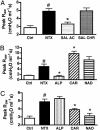Effects of acute and chronic administration of beta-adrenoceptor ligands on airway function in a murine model of asthma
- PMID: 15069206
- PMCID: PMC387354
- DOI: 10.1073/pnas.0400452101
Effects of acute and chronic administration of beta-adrenoceptor ligands on airway function in a murine model of asthma
Abstract
The clinical effects of treatment with beta-adrenoceptor (beta-AR) agonists and antagonists in heart failure vary with duration of therapy, as do the effects of beta-AR agonists in asthma. Therefore, we hypothesized that chronic effects of "beta-blockers" in asthma may differ from those observed acutely. We tested this hypothesis in an antigen (ovalbumin)-driven murine model of asthma. Airway resistance responses (Raw) to the muscarinic agonist methacholine were measured by using the forced oscillation technique. In comparison with nontreated asthmatic mice, we observed that: (i) The beta-AR antagonists nadolol or carvedilol, given as a single i.v. injection (acute treatment) 15 min before methacholine, increased methacholine-elicited peak Raw values by 33.7% and 67.7% (P < 0.05), respectively; when either drug was administered for 28 days (chronic treatment), the peak Raw values were decreased by 43% (P < 0.05) and 22.9% (P < 0.05), respectively. (ii) Chronic treatment with nadolol or carvedilol significantly increased beta-AR densities in lung membranes by 719% and 828%, respectively. (iii) Alprenolol, a beta-blocker with partial agonist properties at beta-ARs, behaved as a beta-AR agonist, and acutely reduced peak Raw value by 75.7% (P < 0.05); chronically, it did not alter Raw. (iv) Salbutamol, a beta-AR partial agonist, acutely decreased peak Raw by 41.1%; chronically, it did not alter Raw. (v) None of the beta-blockers produced significant changes in eosinophil number recovered in bronchoalveolar lavage. These results suggest that beta-AR agonists and beta-blockers with inverse agonist properties may exert reciprocating effects on cellular signaling dependent on duration of administration.
Figures


References
-
- Jessup, M. & Brozena, S. (2003) N. Engl. J. Med. 348, 2007-2018. - PubMed
-
- The Xamoterol in Severe Heart Failure Study Group (1990) Lancet 336, 1-6. - PubMed
-
- Lambertz, H., Meyer, J. & Erbel, R. (1984) Circulation 69, 298-305. - PubMed
-
- Packer, M., Bristow, M. R., Cohn, J. N., Colucci, W. S., Fowler, M. B., Gilbert, E. M. & Shusterman, N. H. (1996) N. Engl. J. Med. 334, 1349-1355. - PubMed
-
- Foody, J. M., Farrell, M. H. & Krumholz, H. M. (2002) J. Am. Med. Assoc. 287, 883-889. - PubMed
Publication types
MeSH terms
Substances
LinkOut - more resources
Full Text Sources
Other Literature Sources
Medical
Molecular Biology Databases
Research Materials

